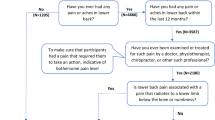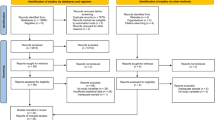Abstract
OBJECTIVES: To examine the associations of low back pain symptoms with waist circumference, height, waist to hip ratio and body mass index, and to test the interactions between (1) waist circumference and height, and (2) waist to hip ratio and body mass index. SETTING: Cross-sectional study set in The Netherlands of a random sample of 5887 men and 7018 women aged 20–60 y. RESULTS: The prevalences of low back pain in men and women in the past 12 months were 46% and 52%, of whom 17% and 21% had low back pain for a total of 12 or more weeks, and 13% and 18% had symptoms suggestive of intervertebral disc herniation. After adjustments for age, smoking and education, more women in the highest tertile of waist circumference reported low back pain in the past 12 months (odds ratio=1.2, 95% confidence interval: 1.1–1.4), low back pain for a total of 12 or more weeks (odds ratio=1.5, 95% confidence interval: 1.3–1.8), and intervertebral disc herniation symptoms (odds ratio=1.3, 95% confidence interval: 1.1–1.6) than women in the lowest waist tertile. Corresponding values of low back pain symptoms for women with high body mass index or high waist to hip ratio were similar to those with high waist. There were no significant differences between men in different tertiles of waist, waist to hip ratio or body mass index reporting low back pain symptoms. Tallest subjects did not report low back pain symptoms more often than shortest subjects. There were no significant interactions between waist and height or between waist to hip ratio and body mass index on low back pain symptoms. CONCLUSIONS: Women who are overweight or with a large waist have a significantly increased likelihood of low back pain. There are no significant interactions between waist and height, or waist to hip ratio and body mass index on low back pain symptoms.
This is a preview of subscription content, access via your institution
Access options
Subscribe to this journal
Receive 12 print issues and online access
$259.00 per year
only $21.58 per issue
Buy this article
- Purchase on Springer Link
- Instant access to full article PDF
Prices may be subject to local taxes which are calculated during checkout
Similar content being viewed by others
Author information
Authors and Affiliations
Rights and permissions
About this article
Cite this article
Han, T., Schouten, J., Lean, M. et al. The prevalence of low back pain and associations with body fatness, fat distribution and height. Int J Obes 21, 600–607 (1997). https://doi.org/10.1038/sj.ijo.0800448
Received:
Revised:
Accepted:
Issue Date:
DOI: https://doi.org/10.1038/sj.ijo.0800448
Keywords
This article is cited by
-
Are there any correlations among the number of discopathy levels and pain intensity or disability in patients with symptomatic low back pain?
Archives of Orthopaedic and Trauma Surgery (2023)
-
Risk factors and association of body composition components for lumbar disc herniation in Northwest, Mexico
Scientific Reports (2020)
-
Dose–response associations of clinical markers of obesity and duration of exposure to excess weight with chronic musculoskeletal pain: cross-sectional analysis at baseline of ELSA-Brasil Musculoskeletal cohort
Rheumatology International (2020)
-
Height loss but not body composition is related to low back pain in community-dwelling elderlies: Shimane CoHRE study
BMC Musculoskeletal Disorders (2019)
-
Central and peripheral fatigue development in the shoulder muscle with obesity during an isometric endurance task
BMC Musculoskeletal Disorders (2017)



